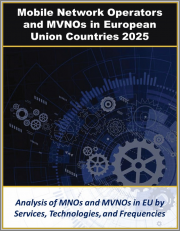
|
시장보고서
상품코드
1462596
세계의 가상통신망 사업자(VNO) 시장 예측 : 유형별, 대상 고객별, 서비스별, 기술별, 최종 사용자별, 지역별 분석(-2030년)Virtual Network Operator Market Forecasts to 2030 - Global Analysis By Type, Target Customer, Service, Technology, End User and By Geography |
||||||
세계의 가상통신망 사업자(VNO) 시장 규모는 2023년 1,008억 5,000만 달러를 차지하였고, 예측 기간 동안 CAGR 9.2%로 성장할 전망이며, 2030년에는 1,867억 5,000만 달러에 이를 것으로 예측됩니다. 가상통신망 사업자는 자사에서 물리적인 네트워크 인프라를 소유하지 않고, 기존의 통신망 사업자로부터 네트워크 용량을 빌리고 있는 통신 서비스 사업자입니다. 음성, 데이터 및 인터넷 연결을 포함한 광범위한 통신 서비스를 최종 사용자에게 제공합니다. VNO는 특정 시장 부문 및 틈새 고객 요구에 맞게 서비스를 사용자 정의할 수 있으며 유연성과 사용자 정의를 제공합니다. 호스트 네트워크 사업자의 인프라를 활용함으로써 VNO는 비용 효율적인 솔루션을 제공할 수 있습니다.
GSMA Intelligence Mobile Economy report 2022에 따르면 2025년까지 4억 명의 신흥 5G 가입자가 예상되며, 네트워크 사업자의 대액 투자와 다양한 가격의 폭넓은 5G 스마트폰이 있기 때문에 소비자의 대부분은 아시아태평양과 사하라 이남의 아프리카에서 나타날 것으로 예상됩니다.
전기통신 서비스에 대한 수요 증가
소비자와 기업 간의 통신에 대한 의존도가 계속 증가함에 따라 VNO는 음성, 데이터 및 인터넷 연결 서비스를 제공하는 비용 효율적인 옵션을 제공합니다. VNO는 기존 사업자로부터 네트워크 인프라를 임대함으로써 통신 서비스를 제공하는 유연하고 확장 가능한 접근 방식을 제공합니다. 따라서 시장에 신속하게 진입하고, 경쟁가격으로 제공하고, 틈새 부문와 서비스가 꽉 차지 않는 지역에 대응할 수 있습니다. 이러한 수요 주도형의 성장은 VNO가 고객 기반을 확대하고, 서비스 제공을 강화하고, 새로운 시장 동향을 활용할 기회를 창출합니다.
보안 및 개인정보 보호에 대한 우려
VNO의 보안 및 개인 정보 보호 문제는 데이터 유출, 기밀 정보에 대한 무단 액세스 및 데이터 보호 규정 준수와 관련된 위험을 포함합니다. VNO는 호스트 통신망 사업자의 인프라에 의존하기 때문에 고객 데이터와 네트워크 통신의 보안을 확보하는 데 어려움을 겪고 있습니다. 이러한 우려에 대처하지 못하면 고객의 신뢰를 해치고, 풍평 피해로 이어져, 법적 및 경제적 영향을 받을 가능성이 있습니다. 결과적으로 보안 및 개인 정보 취약점은 잠재 고객과 투자자를 멀리하여 시장 성장을 방해할 수 있습니다.
시장의 자유화
시장 자유화는 규제 장벽을 줄이고 가상통신망 사업자(VNO)의 공정한 경쟁 환경을 촉진함으로써 통신 분야에서 경쟁과 혁신을 촉진합니다. 시장 진입 및 사업 운영에 대한 규제가 완화됨에 따라 VNO는 호스트 통신망 사업자의 기존 인프라를 활용하여 경쟁력 있는 서비스와 솔루션을 제공할 수 있게 됩니다. 게다가, 시장이 자유화됨에 따라 VNO는 서비스가 깨끗하지 않은 부문과 틈새 부문을 타겟팅할 수 있는 기회를 낳습니다. 이것은 소비자의 선택을 넓히고 가격을 낮추고 기술의 진보를 촉진함으로써 시장 성장을 자극합니다.
기존 통신망 사업자와의 경쟁
기존의 통신망 사업자들은 기존 인프라, 브랜드 인지도, 자금력을 활용하여 번들 서비스, 할인 가격, 우수한 네트워크 커버리지를 제공하는 경우가 많습니다. 이러한 경쟁으로 인해 VNO는 고객을 확보하고 유지하기가 어려워 시장 점유율과 수익 잠재력이 제한될 수 있습니다. 게다가 전통적인 사업자들은 적극적인 마케팅 전술과 독점적인 제휴를 할 수 있어 VNO를 더욱 소외시키고 통신 시장에서 효과적으로 경쟁할 수 있는 능력을 방해하고 있습니다.
COVID-19의 영향
COVID-19의 유행은 가상통신망 사업자 시장에 다양한 영향을 미쳤습니다. 한편으로는 봉쇄시나 원격근무시의 디지털 접속에의 의존도가 높아짐으로써, VNO 서비스에 대한 수요가 높아지고 있습니다. 한편, 공급망 혼란, 경제 불확실성, 개인 소비 감소는 시장 확대에 영향을 미칩니다. 또한, 팬데믹 관련 규제로 인프라를 배포하고 규제 과정을 지연하면 VNO의 성장을 방해하고 있습니다. 전반적으로 팬데믹은 시장 성장에 어려움을 제시하면서 탄력적인 통신 네트워크의 중요성을 돋보이게 했습니다.
가상이동통신망 사업자(MVNO) 부문이 예측 기간 동안 최대가 될 전망
가상이동통신망 사업자(MVNO) 부문은 유리한 성장을 이룰 것으로 추정됩니다. MVNO는 기본 인프라를 소유하지 않고 모바일 서비스를 제공합니다. 대신 MVNO는 기존 MNO에서 네트워크 액세스를 임대하고 자체 브랜드로 고객에게 재판매합니다. MVNO는 일반적으로 특정 인구층과 틈새 시장을 대상으로 맞춤형 서비스를 제공하고 시장 경쟁력 있는 가격 설정과 고유한 기능을 제공함으로써 시장 차별화를 도모합니다. MVNO는 물리적 네트워크 인프라를 소유하지 않고 MNO와의 계약을 활용하여 음성 통화, 메시징, 데이터 통신 등 다양한 모바일 서비스를 제공할 수 있습니다.
예측 기간 동안 기업용 VNO 부문의 CAGR이 가장 높을 것으로 예상
기업용 VNO 부문은 예측 기간 동안 가장 높은 CAGR 성장이 예상됩니다. 기업용 VNO는 기업 및 대기업의 요구에 특화된 전략적 기업입니다. VNO는 모바일, 인터넷, 네트워크 서비스와 같은 통신 솔루션을 제공하며 기업 고객의 까다로운 요구 사항을 충족하도록 설계되었습니다. 기업용 VNO는 확장성과 유연성이 뛰어난 솔루션을 제공함으로써 기업이 통신 인프라를 최적화하고 생산성을 높이고 디지털화가 진행되는 세계에서 경쟁력을 유지할 수 있도록 합니다.
최대 점유율을 차지하는 지역
아시아태평양은 스마트폰 보급, 데이터 서비스 수요 증가, 인터넷 연결 확대로 예측 기간 동안 최대 시장 점유율을 차지할 것으로 예측됩니다. 중국, 인도, 동남아시아 국가들과 같은 국가들은 유리한 규제 정책, 기술 진보, 저렴한 통신 서비스에 대한 소비자 수요 증가로 시장의 대폭적인 확대를 목표로 하고 있습니다. 게다가 대규모 인구와 디지털 경제의 상승은 이 지역의 역동적인 통신 상황을 활용하여 다양한 고객의 요구를 충족시킬 수 있는 유리한 기회를 제공합니다.
CAGR이 가장 높은 지역
예측기간 동안 북미의 CAGR이 가장 높을 것으로 예측되는 것은 통신 기술의 진보가 높아지고 경쟁을 촉진하는 규제적 대처에 의한 것입니다. 미국과 캐나다는 VNO가 혁신적인 비즈니스 모델과 기존 네트워크 사업자와의 제휴를 활용하여 경쟁력 있는 서비스를 제공함으로써 현저한 확대를 이루고 있는 주요 시장입니다. 게다가 스마트폰, IoT 기기, 디지털 서비스의 보급이 시장의 성장을 더욱 가속화하고, VNO가 다양한 소비자 요구에 부응할 기회를 창출하고 있습니다.
무료 맞춤설정 서비스
이 보고서를 구독하는 고객은 다음과 같은 무료 맞춤설정 옵션 중 하나를 제공합니다.
- 기업 프로파일
- 추가 시장 기업의 종합적 프로파일링(3개사까지)
- 주요 기업의 SWOT 분석(3개사까지)
- 지역 세분화
- 고객의 관심에 응한 주요국 시장 추계, 예측 및 CAGR(주 : 타당성 확인에 따름)
- 경쟁 벤치마킹
- 제품 포트폴리오, 지리적 존재, 전략적 제휴에 기반한 주요 기업 벤치마킹
목차
제1장 주요 요약
제2장 서문
- 개요
- 이해관계자
- 조사 범위
- 조사 방법
- 데이터 마이닝
- 데이터 분석
- 데이터 검증
- 조사 접근
- 조사 정보원
- 1차 조사 정보원
- 2차 조사 정보원
- 전제조건
제3장 시장 동향 분석
- 성장 촉진요인
- 억제요인
- 기회
- 위협
- 기술 분석
- 최종 사용자 분석
- 신흥 시장
- COVID-19의 영향
제4장 Porter's Five Forces 분석
- 공급기업의 협상력
- 구매자의 협상력
- 대체품의 위협
- 신규 진입업자의 위협
- 경쟁 기업간 경쟁 관계
제5장 세계의 가상통신망 사업자 시장 : 유형별
- 가상이동통신망 사업자(MVNO)
- 고정 가상통신망 사업자(FVNO)
- 데이터 가상통신망 사업자(DVNO)
- 음성 가상통신망 사업자(VVNO)
- 기타 유형
제6장 세계 가상통신망 사업자 시장 : 대상 고객별
- 기업용 VNO
- 소비자용 VNO
- 전문 VNO
- 리셀러 VNO
- 기타 대상 고객
제7장 세계의 가상통신망 사업자 시장 : 서비스별
- 음성 서비스
- 데이터 서비스
- 메시지 서비스
- 보안 서비스
- 매니지드 서비스
- 기타 서비스
제8장 세계의 가상통신망 사업자 시장 : 기술별
- IoT(사물인터넷) VNO
- 클라우드 VNO
- SD-WAN(소프트웨어 정의 광역 네트워크) VNO
- 블록체인 베이스 VNO
- 기타 기술
제9장 세계 가상통신망 사업자 시장 : 최종 사용자별
- 헬스케어
- 소매
- 은행, 금융서비스 및 보험(BFSI)
- 운송
- 교육
- 정부
- 기타 최종 사용자
제10장 세계 가상통신망 사업자 시장 : 지역별
- 북미
- 미국
- 캐나다
- 멕시코
- 유럽
- 독일
- 영국
- 이탈리아
- 프랑스
- 스페인
- 기타 유럽
- 아시아태평양
- 일본
- 중국
- 인도
- 호주
- 뉴질랜드
- 한국
- 기타 아시아태평양
- 남미
- 아르헨티나
- 브라질
- 칠레
- 기타 남미
- 중동 및 아프리카
- 사우디아라비아
- 아랍에미리트(UAE)
- 카타르
- 남아프리카
- 기타 중동 및 아프리카
제11장 주요 발전
- 협정, 파트너십, 협업 및 합작 사업
- 인수 및 합병
- 신제품 발매
- 사업 확대
- 기타 주요 전략
제12장 기업 프로파일링
- Google Fi
- Red Pocket Mobile
- Republic Wireless
- TracFone Wireless Inc.
- Consumer Cellular
- Mint Mobile LLC
- Ting Mobile
- Allo Communications
- H2O Wireless
- FreedomPop
- Lycamobile
- Ultra Mobile
- Boost Mobile
- Cricket Wireless
According to Stratistics MRC, the Global Virtual Network Operator Market is accounted for $100.85 billion in 2023 and is expected to reach $186.75 billion by 2030 growing at a CAGR of 9.2% during the forecast period. Virtual network operators are telecom service providers that do not own their own physical network infrastructure but lease network capacity from established carriers. They offer a wide range of telecommunications services, including voice, data, and internet connectivity, to end-users. VNOs can tailor their services to meet specific market segments or niche customer needs, offering flexibility and customization. By leveraging the infrastructure of host network operators, VNOs can provide cost-effective solutions.
According to the GSMA Intelligence Mobile Economy report 2022, 400 million emerging 5G subscribers are expected by 2025, with a majority of consumers emerging from Asia Pacific and Sub-Saharan Africa due to heavy investments from network operators and the wide range of 5G smart phones at varying prices.
Market Dynamics:
Driver:
Increasing demand for telecom services
As consumer and business reliance on telecommunications continues to grow, VNOs offer a cost-effective alternative for providing voice, data, and internet connectivity services. VNOs offer a flexible and scalable approach to providing telecommunications services by leasing network infrastructure from established operators. This enables them to enter the market quickly, offer competitive pricing, and cater to niche segments or underserved areas. This demand-driven growth creates opportunities for VNOs to expand their customer base, enhance service offerings, and capitalize on emerging market trends.
Restraint:
Security and privacy concerns
Security and privacy concerns in the VNO include risks related to data breaches, unauthorized access to sensitive information, and compliance with data protection regulations. As VNOs rely on the infrastructure of host network operators, they face challenges in ensuring the security of customer data and network communications. Failure to address these concerns can erode customer trust, lead to reputational damage, and result in legal and financial repercussions. Consequently, security and privacy vulnerabilities can hinder market growth by deterring potential customers and investors.
Opportunity:
Market liberalization
Market liberalization fosters competition and innovation in the telecommunications sector by reducing regulatory barriers and promoting a level playing field for Virtual Network Operators (VNOs). With fewer restrictions on market entry and operations, VNOs can leverage existing infrastructure from host network operators to offer competitive services and solutions. Additionally, liberalized markets create opportunities for VNOs to target underserved or niche segments. This stimulates market growth by expanding consumer choice, driving down prices, and encouraging technological advancements.
Threat:
Competition from traditional operators
Established telecom operators often leverage their existing infrastructure, brand recognition, and financial resources to offer bundled services, discounted pricing, and superior network coverage. This competition can make it difficult for VNOs to attract and retain customers, limiting their market share and revenue potential. Additionally, traditional operators may engage in aggressive marketing tactics or exclusive partnerships, further marginalizing VNOs and hindering their ability to compete effectively in the telecommunications market.
Covid-19 Impact
The covid-19 pandemic has mixed impact on the virtual network operator market. On one hand, the increased reliance on digital connectivity during lockdowns and remote work arrangements has driven demand for VNO services. On the other hand, disruptions to supply chains, economic uncertainties, and reduced consumer spending have affected market expansion. Additionally, delays in infrastructure deployments and regulatory processes due to pandemic-related restrictions have hindered the growth of VNOs. Overall, the pandemic has highlighted the importance of resilient telecommunications networks while presenting challenges to market growth.
The mobile virtual network operator (MVNO) segment is expected to be the largest during the forecast period
The mobile virtual network operator (MVNO) segment is estimated to have a lucrative growth. A MVNO offers mobile services without owning the underlying infrastructure. Instead, MVNOs lease network access from traditional MNOs and then resell it to their customers under their brand. They typically target specific demographics or niches with tailored services, often offering competitive pricing or unique features to differentiate themselves in the market. While they don't own the physical network infrastructure, MVNOs can still provide a range of mobile services, including voice calls, messaging, and data, by leveraging agreements with MNOs.
The enterprise VNO segment is expected to have the highest CAGR during the forecast period
The enterprise VNO segment is anticipated to witness the highest CAGR growth during the forecast period. Enterprise VNOs are strategic players, catering specifically to the needs of businesses and large corporations. They offer tailored telecommunications solutions, including mobile, internet, and network services, designed to meet the demanding requirements of enterprise clients. By providing scalable and flexible solutions, Enterprise VNOs enable businesses to optimize their communication infrastructure, enhance productivity, and stay competitive in an increasingly digital world.
Region with largest share:
Asia Pacific is projected to hold the largest market share during the forecast period owing to increasing smartphone penetration, rising demand for data services, and expanding internet connectivity. Countries like China, India, and Southeast Asian nations are witnessing significant market expansion driven by favourable regulatory policies, technological advancements, and growing consumer demand for affordable telecommunications services. Moreover, the presence of a large population, coupled with the emergence of digital economies, presents lucrative opportunities to capitalize on the region's dynamic telecommunications landscape and cater to diverse customer needs.
Region with highest CAGR:
North America is projected to have the highest CAGR over the forecast period, owing to rising advancements in telecommunications technology and regulatory initiatives promoting competition. The United States and Canada are key markets witnessing significant expansion, with VNOs leveraging innovative business models and partnerships with established network operators to offer competitive services. Additionally, the proliferation of smart phones, IoT devices, and digital services further accelerates market growth, creating opportunities for VNOs to cater to diverse consumer needs.
Key players in the market
Some of the key players profiled in the Virtual Network Operator Market include Google Fi, Red Pocket Mobile, Republic Wireless, TracFone Wireless Inc., Consumer Cellular, Mint Mobile LLC, Ting Mobile, Allo Communications, H2O Wireless, FreedomPop, Lycamobile, Ultra Mobile, Boost Mobile and Cricket Wireless.
Key Developments:
In November 2023, Allo Communications, a fiber network operator serving parts of Nebraska, Colorado and Arizona, confirmed to Light Reading it plans to launch mobile services in the first quarter of 2024. Allo's new strategy puts the company alongside T-Mobile, AT&T, Omnipoint and others in selling mobile services next to fiber services.
In June 2022, Google Fi started sharing MVNO revenues with Wi-Fi operators at big venues. The move is noteworthy because it offers a public, commercial mechanism that pairs Wi-Fi with 5G, allowing third-party Wi-Fi network operators to indirectly profit from smartphone users who roam onto their networks.
Types Covered:
- Mobile Virtual Network Operator (MVNO)
- Fixed Virtual Network Operator (FVNO)
- Data Virtual Network Operator (DVNO)
- Voice Virtual Network Operator (VVNO)
- Other Types
Target Customers Covered:
- Enterprise VNO
- Consumer VNO
- Specialized VNO
- Reseller VNO
- Other Target Customers
Services Covered:
- Voice services
- Data services
- Messaging services
- Security services
- Managed services
- Other Services
Technologies Covered:
- IoT (Internet of Things) VNOs
- Cloud VNOs
- SD-WAN (Software-Defined Wide Area Network) VNOs
- Blockchain-based VNOs
- Other Technologies
End Users Covered:
- Healthcare
- Retail
- Banking, Financial Services, & Insurance (BFSI)
- Transportation
- Education
- Government
- Other End Users
Regions Covered:
- North America
- US
- Canada
- Mexico
- Europe
- Germany
- UK
- Italy
- France
- Spain
- Rest of Europe
- Asia Pacific
- Japan
- China
- India
- Australia
- New Zealand
- South Korea
- Rest of Asia Pacific
- South America
- Argentina
- Brazil
- Chile
- Rest of South America
- Middle East & Africa
- Saudi Arabia
- UAE
- Qatar
- South Africa
- Rest of Middle East & Africa
What our report offers:
- Market share assessments for the regional and country-level segments
- Strategic recommendations for the new entrants
- Covers Market data for the years 2021, 2022, 2023, 2026, and 2030
- Market Trends (Drivers, Constraints, Opportunities, Threats, Challenges, Investment Opportunities, and recommendations)
- Strategic recommendations in key business segments based on the market estimations
- Competitive landscaping mapping the key common trends
- Company profiling with detailed strategies, financials, and recent developments
- Supply chain trends mapping the latest technological advancements
Free Customization Offerings:
All the customers of this report will be entitled to receive one of the following free customization options:
- Company Profiling
- Comprehensive profiling of additional market players (up to 3)
- SWOT Analysis of key players (up to 3)
- Regional Segmentation
- Market estimations, Forecasts and CAGR of any prominent country as per the client's interest (Note: Depends on feasibility check)
- Competitive Benchmarking
- Benchmarking of key players based on product portfolio, geographical presence, and strategic alliances
Table of Contents
1 Executive Summary
2 Preface
- 2.1 Abstract
- 2.2 Stake Holders
- 2.3 Research Scope
- 2.4 Research Methodology
- 2.4.1 Data Mining
- 2.4.2 Data Analysis
- 2.4.3 Data Validation
- 2.4.4 Research Approach
- 2.5 Research Sources
- 2.5.1 Primary Research Sources
- 2.5.2 Secondary Research Sources
- 2.5.3 Assumptions
3 Market Trend Analysis
- 3.1 Introduction
- 3.2 Drivers
- 3.3 Restraints
- 3.4 Opportunities
- 3.5 Threats
- 3.6 Technology Analysis
- 3.7 End User Analysis
- 3.8 Emerging Markets
- 3.9 Impact of Covid-19
4 Porters Five Force Analysis
- 4.1 Bargaining power of suppliers
- 4.2 Bargaining power of buyers
- 4.3 Threat of substitutes
- 4.4 Threat of new entrants
- 4.5 Competitive rivalry
5 Global Virtual Network Operator Market, By Type
- 5.1 Introduction
- 5.2 Mobile Virtual Network Operator (MVNO)
- 5.3 Fixed Virtual Network Operator (FVNO)
- 5.4 Data Virtual Network Operator (DVNO)
- 5.5 Voice Virtual Network Operator (VVNO)
- 5.6 Other Types
6 Global Virtual Network Operator Market, By Target Customer
- 6.1 Introduction
- 6.2 Enterprise VNO
- 6.3 Consumer VNO
- 6.4 Specialized VNO
- 6.5 Reseller VNO
- 6.6 Other Target Customers
7 Global Virtual Network Operator Market, By Service
- 7.1 Introduction
- 7.2 Voice services
- 7.3 Data services
- 7.4 Messaging services
- 7.5 Security services
- 7.6 Managed services
- 7.7 Other Services
8 Global Virtual Network Operator Market, By Technology
- 8.1 Introduction
- 8.2 IoT (Internet of Things) VNOs
- 8.3 Cloud VNOs
- 8.4 SD-WAN (Software-Defined Wide Area Network) VNOs
- 8.5 Blockchain-based VNOs
- 8.6 Other Technologies
9 Global Virtual Network Operator Market, By End User
- 9.1 Introduction
- 9.2 Healthcare
- 9.3 Retail
- 9.4 Banking, Financial Services, & Insurance (BFSI)
- 9.5 Transportation
- 9.6 Education
- 9.7 Government
- 9.8 Other End Users
10 Global Virtual Network Operator Market, By Geography
- 10.1 Introduction
- 10.2 North America
- 10.2.1 US
- 10.2.2 Canada
- 10.2.3 Mexico
- 10.3 Europe
- 10.3.1 Germany
- 10.3.2 UK
- 10.3.3 Italy
- 10.3.4 France
- 10.3.5 Spain
- 10.3.6 Rest of Europe
- 10.4 Asia Pacific
- 10.4.1 Japan
- 10.4.2 China
- 10.4.3 India
- 10.4.4 Australia
- 10.4.5 New Zealand
- 10.4.6 South Korea
- 10.4.7 Rest of Asia Pacific
- 10.5 South America
- 10.5.1 Argentina
- 10.5.2 Brazil
- 10.5.3 Chile
- 10.5.4 Rest of South America
- 10.6 Middle East & Africa
- 10.6.1 Saudi Arabia
- 10.6.2 UAE
- 10.6.3 Qatar
- 10.6.4 South Africa
- 10.6.5 Rest of Middle East & Africa
11 Key Developments
- 11.1 Agreements, Partnerships, Collaborations and Joint Ventures
- 11.2 Acquisitions & Mergers
- 11.3 New Product Launch
- 11.4 Expansions
- 11.5 Other Key Strategies
12 Company Profiling
- 12.1 Google Fi
- 12.2 Red Pocket Mobile
- 12.3 Republic Wireless
- 12.4 TracFone Wireless Inc.
- 12.5 Consumer Cellular
- 12.6 Mint Mobile LLC
- 12.7 Ting Mobile
- 12.8 Allo Communications
- 12.9 H2O Wireless
- 12.10 FreedomPop
- 12.11 Lycamobile
- 12.12 Ultra Mobile
- 12.13 Boost Mobile
- 12.14 Cricket Wireless



















